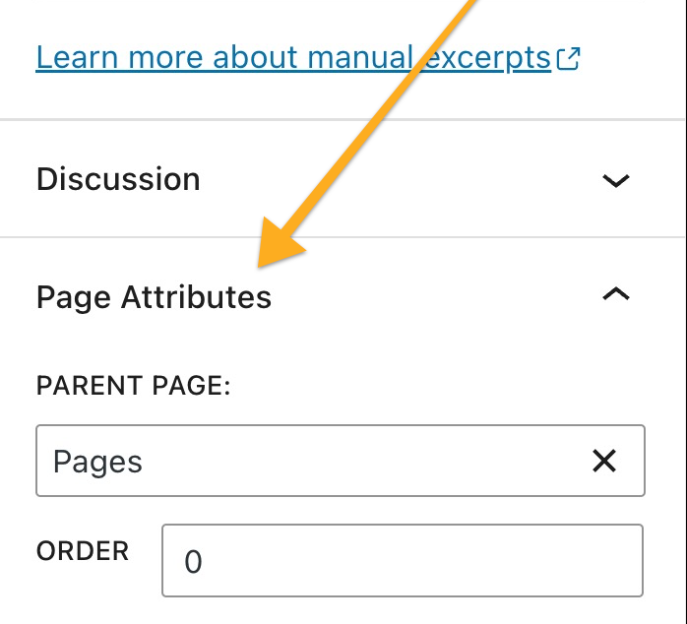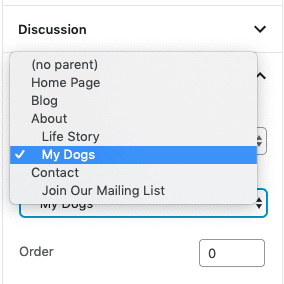The Page Attributes module is a setting for Pages to set parent pages and change the order of your pages. This guide will cover how to use these settings.
In this guide
To find the Page Attributes settings, take the following steps:
- Visit your dashboard.
- Click on Pages from the options on the left.
- Click on the title of the page to open the editor.
- In the settings sidebar on the right, locate the “Page Attributes” section.

The “Parent Page” setting organizes your pages into hierarchies. A “parent” is a top-level page with “child” pages nested under it.
For example, you could have an “About” page as a top-level (i.e., parent) page and then have child pages called “Life Story” and “My Dogs” under it. Under “My Dogs,” you could have another page titled “Rosco.”

Parent and child page relationships are reflected in the page URLs. In the above example, the page URLs would be:
There are no limits to how deeply you can nest pages.
To assign a parent page to the page you’re working on, take the following steps:
- Access the Page Attributes settings as explained above.
- In the box labeled “Parent Page,” search for the name of the page you want to set as the parent and click on it.
- Click the “Publish,” “Update,” or “Save” button at the top of the screen to save your change.
The parent page will be displayed in the box like so:

📌
Some page URLs, such as “author,” “tag,” and “category” are reserved for special uses. You can’t create a child page if the parent page uses one of those reserved names.
Using parent pages does not affect how pages appear in your site’s navigation menu. Visit our guide on how to Create Drop-Down Menus to learn how to make submenu items.
An exception is if you use your site’s default menu to display all pages and automatically update the menu with newly published pages. In that case, parent pages usually show in the menu with child pages as a drop-down. Not all themes display page hierarchies by default in the navigation menu.
The use of the “Page Order” option does not affect how pages appear in your site’s navigation menu. Visit our guide on how to Reorder Menu Items.
An exception is if you use your site’s default menu to display all pages and automatically update the menu with newly published pages. You can change the order in which your pages are displayed when using a default menu by using the “Page Order” option.
Let’s say you have three pages: About, Photos, Contact
If you wanted About to appear first, you’d need to do the following:
- Access the Page Attributes settings as explained above.
- Put the number 1 in the box labeled “Order“. This tells WordPress to display this page first.
- Click the “Publish,” “Update,” or “Save” button to save your change for that page.
- Repeat the process for your other pages, but use consecutive numbers for the “Order” field: 2, 3, etc. This tells WordPress to display these pages second and third.

